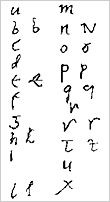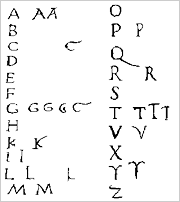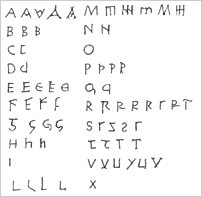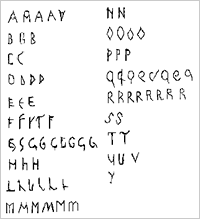| Graphic
Design in History |
Alphabet
and type developments |
|
|
| Quote |
| Alphabet
- [Gr. alpha-beta, like
Eng. ABC], system of writing,
theoretically having a one-for-one
relation between character
(or letter) and phoneme |
| |
| Source
Source © Copyright
Helicon Publishing Group
plc. 1998 |
|
|
| Writing tools like
ink, paper (papyrus)
and various writing systems were
used in Ancient Times but the
developments of International
Phonetic Alphabet (IPA with type
variations as we know it today),
was gradual; it took many stages,
which were based and differ from
country to country, territory,
people, trade, political or religions
situation and needs. Each stage
of development in this essay is
outlined by either: name or period
within century or art movement,
as an easy indentification of
change. |
|
|
| |
|
|
| |
| Through Persian
Empire, Mesopotamia, Egypt, and China
people developed various writing systems like
Cunei Form, Arabic or Hieroglyphic script
which influenced developments of modern alphabets.
|
| |
 |
The
Sumerians
used logographic systems with wedge-shaped
strokes engraved on stone or clay written
from top to bottom and from right to
left with the pictographs facing the
beginning of the line and known as Cunei
form used 5.000 years ago by the
ancient people of Western Asia. |
| |
| Left
example of: Mesopotamian document Document
written in Cunei Form script commemorating
the building of the Singashid Palace
of the King of Urk (1800BC). Museum
of the Biblical Orient, Monastery of
Montserrat. |
|
| |
| Egyptian
Writing |
| In Egypt writing
script was called Hieroglyphic,
where the characters were created in a form
of a simplified drawing, symbols,
a picture or icon associated with person,
animal or activity of that time. Egyptian
writing system is divided in to 3 categories
as: Logograms, Phonograms and Determinatives
- glyph
[dictionary]
[example]. |
| |
| Chinese
Writing |
|
Chinese
writing is as old as the Sumerians and the
symbols used for writing from top to bottom
was developed gradually from pictograms
to ideograms and then in to phonetic
symbols. The Chinese added an ideogram to
each phonetic symbol to limit the number
of sounds within their alphabet. By the
first century the Chinese developed a vocabulary
of over 50.000 words and in time other accents,
dialects and even separate languages emerged.
The evolution of the Chinese alphabet can
be divided into 4 stages
as: Oracle Bone Script, Greater Seal, Lesser
Seal or Clerkly Script.
|
| |
| The
Phoenician Alphabet |
|
Phoenician
people and their colonies occupying the
coast of Syria, from were they exported
all sort of goods to other Mediterranean
countries like: Spain, Cyprus, Greece and
Italy. Their is considered as the first
phonetic alphabet because is made up from
consonants letters, which represent a sound.
It was made from 22 signs, but there are
no written vowels in it and they were only
pronounced and written from right to left.
The Phoenician
alphabet is based on the Proto-Sinaitic
script and both played important part in
further developments of other modern scripts
like the Arabic, Hebrew, Latin, and Greek.
|
| |
| The
Greek |
| The Greek
Alphabet (750 B.C.) was the first to emerge
in Europe, based on the Phoenician, where
some fundamental changes have been made by
the Greeks in adding vowels and arranged letters
geometrically. Most stone inscriptions made
by the Greeks were carefully spaced and elegant
showing its line angle and round geometrical
organized letters in detail. Greek language
and writing system is known as Cyrillic alphabet
and early example of inscription can be seen
below. |
| |
 |
EM
6212 (IG I3 507a)
Inscribed poros stele, dedicated to
the goddess Athena, concerning the institution
of the Panathenaic Games (566 B.C.).
Height 0,36, width 0,68, thickness 0,25
m.[source] |
|
|
| The
Romans |
| Etruscan
civilization (Ancient Romans) lay the foundation
and traditions occupying the Northern part
and the Greeks occupied the southern part
of Italy
until the arose of the Roman Empire by the
1st century A.D. in Western Europe with it's
capital in Rome. The intellect driven society
took pride in their accomplishments and the
outcomes were noted in their literature in
form of poems, Chronicles, Classical text
or codex
(which was made out of parchment and was more
durable then papyrus scroll) hand written
using capitals letters. |
| |
| Roman
Square Capitals - 'capitals quadrata'
was unifying alphabet developed by the Romans
used mainly for inscriptions on stone, example
below. The Capitals were drawn in a square
form and constructed with compass in aim to
produce the perfect Letter Form. |
| |
 |
| Roman
Capitals, an inscription on the base of the
Trojan Column AD 114, photographic reconstruction |
| Variations
of early Roman Alphabets were: |
| Rustic
Capitals - otherwise called 'rustica
capitals', Brush-written or Informal developed
around the 2nd century BC and used in Europe
until the 5th century. The rounded shapes
and the narrow letters made easy for scribers
to engrave, but because the letters were only
capitals the inscriptions were quite big.
|
| |
 |
| |
| Roman
Uncial and Half Uncial - The
name Uncial given by the Romans was taken
from the name of a Roman coin and it has been
used up to the thirteenth century - today
referred to as majuscules
script used in formal purposes. The letterforms
are rounded, quick and easy to join into words
in book writing. Uncial was eventually adopted
as a lower case of the Roman Alphabet. |
| |
 |
<
Roman Uncial example |
| |
|
 |
< Roman
Half Uncial example |
|
| |
 |
< Informal Roman example |
| Informal
writing used for everyday letter writing.
AD 166 London British
Library [examples],
also known as the Old Roman Cursive.
[info] |
|
| |
 |
 |
| New
Roman Cursive - less formal |
Trojan
Transitional and Variants |
|
|
|
|
|
| |
| Examples
of early European Alphabets based on the Roman
Rustic Capitals
|
 |
 |
| Above:
Spanish Alphabet |
Above:
German Alphabet |
|
| |
| The
very well organized political structure (governing
system), Latin
language and religion of the Roman Empire
spread rapidly through whole of Europe embracing
Roman culture. In no time Europe become multicultural
state which included Greco-Roman, Celts, Germanic,
Britons, Gaul tribes and other smaller provinces. |
| |
| Quote |
| "For
the entire millennium of
Greco-Roman antiquity this
poem [Iliad]
was the greatest unifying,
civilizing factor in the
classical world, forming
the indispensable basis
of its educational system
and exerting a thousand
effects on its literary,
moral, social, and political
thinking. Throughout subsequent
ages, too, the influence
of the Iliad on writers
and painters has been immeasurable." |
| |
| Source
By Michael
Grant |
|
|
| Literature was
in Greek and Latin and in writing
the Roman Capitals were used with
some modification to accommodate
Europe's dialects. by adding additional
letters like W, J, Y, Z forming
Phonetic Alphabet with 26 letters
as we know it today. |
| At the end
of Roman Empire and beginning
of the Middle Ages from around
5th-15nth century the period is
very often referred to as the
link between the Old and New World.
|
| As in general society
well-being and cultural development
is dependent on stable environment,
in Europe turbulent time was on
the way as civil wars, barbarian
invasions and eventually a collapse
of the Western
Roman Empire. Europe was divided
in to independent tribes as: Ireland
- Celtic;
England - Anglo/Saxon;
France and Northern Italy - Merovingian
/
Charlemagne; Germany - Germanic/Franks,
Spain - Visigothic,
part of Italy- Lombards,
Slavic, Bulgars, Serbs, and Russians
- Huns
and Balkans - Goths
tribes. |
| |
|
| |
| Quote |
| 'Terrible
ordeal for the entire body
that dims your eyes, makes
your back ache and knits
one's chest and stomach
together...' |
| |
| Source
History
of Graphic Design [b] |
|
|
|
| |
|
The only strong universal
European institutions was the church with
their monasteries and abiding 'monasticism'
which was a solitary but intellectual and
cultural environment, spreading their literacy
by monks and regional bishops preaching
the Bible and producing manuscripts
based on the classical
text. Secular
book production was carried out by educated
members of the clergy (scribes
or scriptores, laymen and painters in miniatures)
which later were exchanged for land or livestock
with landowners and other tradesman.
|
| |
| Lettering style
was developing along book production at first
using the Roman - cursive where scribers/copisti
mixed other known hand style lettering like
cursive, rustic, uncial and capitals to suit
their requirements, paying attention to page
layout and decoration in their Bible and codex.
A scribe from this period Prior Petris described
writing as: |
|
|
| 'After
The Romans'
disputes on religion and power, conquests,
invasions and crusades
(between Byzantine Empire and between European
tribes) was taking place so the activity of
commerce, trading, creative and cultural developments
were practically at standstill until revival
and enforcement of stable medieval governing
power by the kings and Roman Catholic Church,
which together made a strong unifying alliance
going into the Higher period of Middle Ages
around 1045 in Europe. |
| continue
.... > Europe
|
| |
|
| |
|
|